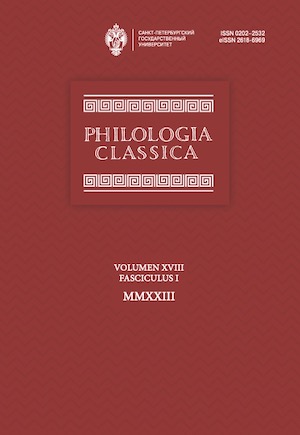On the origin and the structure of Latin medical adjectives of the coccygeus type
DOI:
https://doi.org/10.21638/spbu20.2023.106Аннотация
В статье рассматривается вопрос о количестве гласного e в финали -eus латинских медицинских терминологических прилагательных типа coccygeus. В данную группу входят прилагательные, не связанные с древнелатинскими существительными и не имеющие диграфа в греческом прототипе на стыке основы и суффикса: anconeus, coccygeus, laryngeus, phalangeus, pharyngeus. Автор исследовал историю этих лексем и обнаружил, что они были искусственно созданы анатомами в период с XVI по XVIII век: Жаном Риоланом (младшим), Джеймсом Дугласом, Уильямом Чеселденом и Кристианом Г. Т. Шрегером. Написание этих слов с финалью -.us в работе Дугласа 1707 года было неудавшейся (и неудачной) попыткой унифицировать написание латинских медицинских прилагательных на -eus. Следующая такая попытка принадлежит Чеселдену (1713), который пишет такие лексемы, используя финаль -eus. Искусственное происхождение, наличие вариантов написания (-œus и -eus) и идентичной по написанию латинской морфемы (-ĕus), а также упрощение написания латинских терминов стали причинами появления различных вариантов прилагательных типа coccygeus: с финалями -aeus, -ēus, -ĕus. В то же время существовало исконное латинизированное греческое прилагательное — coccygius (от κοκκύγιος, что встречается у Павсания). Автор статьи предлагает изменить номенклатурное написание прилагательных типа coccygeus, приведя их в соответствие с историческим .живым. обликом: anconius, coccygius, laryngius, phalangius и pharyngius. До тех пор, пока данные изменения не будут осуществлены, рекомендуется считать ⟨e⟩ в финали этих лексем кратким и ставить ударение на третий от конца слог.
Ключевые слова:
coccygeus, копчиковый, латинская анатомическая терминология, номенклатура
Скачивания
Библиографические ссылки
Загрузки
Опубликован
Как цитировать
Выпуск
Раздел
Лицензия
Статьи журнала «Philologia Classica» находятся в открытом доступе и распространяются в соответствии с условиями Лицензионного Договора с Санкт-Петербургским государственным университетом, который бесплатно предоставляет авторам неограниченное распространение и самостоятельное архивирование.






